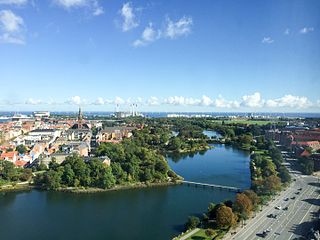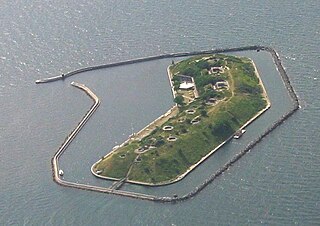 W
WThe fortifications of Copenhagen is the broad name for the rings of fortifications surrounding the city of Copenhagen. They can be classified historically as follows:The medieval fortifications dating from the 12th century The bastioned fortifications dating from the 17th century The ring fortification system dating from the 19th century
 W
WThe fortifications of Copenhagen underwent a comprehensive modernization and expansion in the 17th century. The project was commenced and was largely the masterplan of Christian IV in the early 17th century but was continued and completed by his successors. The new fortifications relied on the existing, medieval fortifications of the city but the fortified area was extended and a defensive ring around the city completed particularly with new edifices facing the sea. The ring fortification consisted of four bastioned ramparts and an annexed citadel as well as various outworks.
 W
WThe Garderhøj Fort is Danish fortification, and was part of Copenhagen's fortifications.
 W
WAbsalon's Castle, was a fortification on the island of Slotsholmen in Copenhagen, located at the site of the later Copenhagen Castle and Christiansborg Palace. According to the chronicler Saxo Grammaticus, the castle was founded by Bishop Absalon in 1167 to protect the emerging city of Copenhagen. The castle survived for 200 years before it was destroyed in 1369 by the Hanseatic League, who first occupied and plundered it, and then demolished it completely.
 W
WCarlstad was a short lived fortified town in Denmark built by the forces of King Charles X Gustav of Sweden during his assault on Copenhagen (1659).
 W
WChristian IV's Brewhouse is a building in Copenhagen, Denmark, dating from 1608. In spite of the name under which it is known today, the building was not originally built for the purpose of brewing beer. It is located on Slotsholmen by the harbourfront and was constructed for military purposes as a corner bastion, part of Christian IV's fortification of the city.
 W
WChristianshavns Enveloppe is a former system of outworks located in front of Christianshavns Vold and Stadsgraven, on Amager. in Copenhagen, Denmark. Its well-preserved, northern half is now part of Freetown Christiania and known as Dyssen. Its southern portion was removed in the first half of the 20th century and has now been replaced by a public park, Enveloppeparken.
 W
WChristianshavns Vold is a former rampart which was part of the bastioned fortification ring which used to surround Copenhagen, Denmark. Running along the full south-eastern perimeter of Christianshavn and Holmen, it used to form a protective barrier towards the island of Amager. It consists of earthworks with 12 bastions and in front of it ran a moat, Stadsgraven, now forming a broad canal which separates Christianshavn from the rest of Amager. On the other side of Stadsgraven. on Amager, was a lower system of outworks called Christianshavns Enveloppe of which only the northern half survives. Along with Kastellet on the other side of the harbour, it is the only intact part of the fortification system.
 W
WFæstningens Materialgård is a former military storage facility at 30 Frederiksholms Kanal in Copenhagen, Denmark. Arranged around a central courtyard, the individual buildings have been built to a homogeneous design, all with yellow-washed facades, green doors and gates, white window frames and red tile roofs, but they have in fact been accumulated over an extended period of time, mainly between 1740 and 1925. They also integrate visually and physically with the adjacent Civiletatens Materialgård, a storage facility associated with the royal palaces, and the Royal Horse Guards Barracks, together forming an area of low, yellow buildings surrounded on three sides by Frederiksholm Canal, Bryghusgade and Vester Voldgade.
 W
WFæstningskanalen is a canal in central Kongens Lyngby, Lyngby-Taarbæk Municipality, Copenhagen, Denmark. Created in the 1880s as part of the new fortification ring around the Danish capital, it runs from Lyngby Lake in the west to Lyngby Hovedgade in the east. From there it originally continued to Ermelunden in Jægersborg Dyrehave, but this last leg of the canal is no longer filled with water. The project also included a more upstream straightening of the section of Mølleåen that connects Furesø in the west to the west side of Lyngby Lake in the east. The canal complemented the West Rampart (Vestvolden) and a series of coastal fortresses which were built at the same time. In the event of an enemy invasion, a dam at each end of the canal, one at Frederiksdal and one at Ermelunden, would be opened, and the natural drainage of Lyngby Lake would be blocked, leading to the flooding of an extensive area of land along Hvidørebækken all the way out to the Øresund coast. Water would also be led through Gentofte Lake to Utterslev Mose, leading to further floodings. Together with the moat in front of the West Rampart, this would create a complete water barrier around the Danish capital.
 W
WFlakfortet, meaning sand-shoal fortress, is a sea fort located on the artificially built island of Saltholmrev, in the Øresund between Copenhagen and Saltholm. The island and fort are simply known as Flakfortet; the name of the island; Saltholmrev, meaning the reef near Saltholm, is seldom used.
 W
WThe Fortification Ring in Copenhagen, Denmark, is a collective name used to refer to the grounds where the city's old 17th-century fortifications used to lie, now surrounding the City Centre. Since the fortifications were decommissioned in 1870, the Fortification Ring has been dominated by a number of parks and distinctive greenspaces and it is still maintained and developed as a green belt within the city limits, running between the city centre and the -bro districts. The ramparts, bastions and moats of the former fortifications are still clearly seen in the topography. At Christianshavn and the citadel Kastellet, the fortifications have been preserved and remain intact.
 W
WJarmer's Tower is an old ruined tower in Copenhagen, Denmark. It was once part of the Copenhagen moat. Jarmers Tower represents the remains of the original eleven towers which were once joined together as a part of the city’s medieval fortification.
 W
WKastellet located in Copenhagen, Denmark, is one of the best preserved fortresses in Northern Europe. It is constructed in the form of a pentagon with bastions at its corners. Kastellet was continuous with the ring of bastioned ramparts which used to encircle Copenhagen but of which only the ramparts of Christianshavn remain today.
 W
WMiddelgrundsfortet or Fort Middelgrund, known as Ungdomsøen since 2015, is a sea fort located on an artificial island in the Øresund between Copenhagen and Malmö. The fortress is constructed at a point where the seabed is 7 meters below the water surface, and at the northern meeting point of the straits Kongedybet and Hollænderdybet.
 W
WMosede Fort, located in Mosede, Denmark is a coastal fort, part of Tunestillingen, built in the years before and during the First World War, to protect the Bay of Køge from possible German naval invasions. It is now a protected area with a museum, grassy fields for recreation and a restaurant.
 W
WPrøvestenen, also known as Benzinøen, is an artificial island off the northeast coast of Amager in Copenhagen, Denmark. It is located between the Amager Hill combined incineration plant and ski slope to the north and Amager Strandpark to the south. It was created as a marine fortress to guard the entrance to Copenhagen Harbour in the second half of the 18th century and served military purposes until 1922. It now houses the city's petroleum harbor. Prøvestensbroen at the end of Prags Boulevard links it with the rest of Amager.
 W
WStadsgraven is the canal which separates Christianshavn from the rest of Amager in Copenhagen, Denmark. It was originally a moat located in front of the Christianshavn Rampart as part of the city's Bastioned Ring Fortifications.
 W
WTrekroner Søfort is a sea fort at the entrance to the Copenhagen harbour. From 1713 until after World War I, Trekroner Fort was part of the fortifications of Copenhagen.
 W
WVangede Battery, located in Vangede, Gentofte Municipality, is a former military structure and current park in the northern suburbs of Copenhagen, Denmark.
 W
WVestvolden is a rampart complex west of Copenhagen, Denmark. Stretching approximately 14 kilometres (9 mi) from Avedøre in the south to Utterslev Mose in the north, it is part of the last generation of land fortifications of the city. Built in the period 1888–1892 by up to 2,000 workers, it was the largest construction project of its time in Denmark. Vestvolden was divided into two fortifications end to end, the southern one named Vestenceinten and the northern, much shorter one named Husumenceinten; the name Vestvolden emerged as an informal collective term for the two. The building of this fortification system began during the so-called "Provisorietiden" 1885–1894. Under the Prime Minister who lacked a parliamentary majority but still refused to resign, J.B.S. Estrup. Instead this Prime Minister managed to enforce his annual Financial Laws, by bringing about King Christian IX's support for Provisional Financial Laws. This included support from the so-called Landstinget as well. The Landstinget was a smaller assembly of politicians, of which half of its members were chosen by the Monarch.